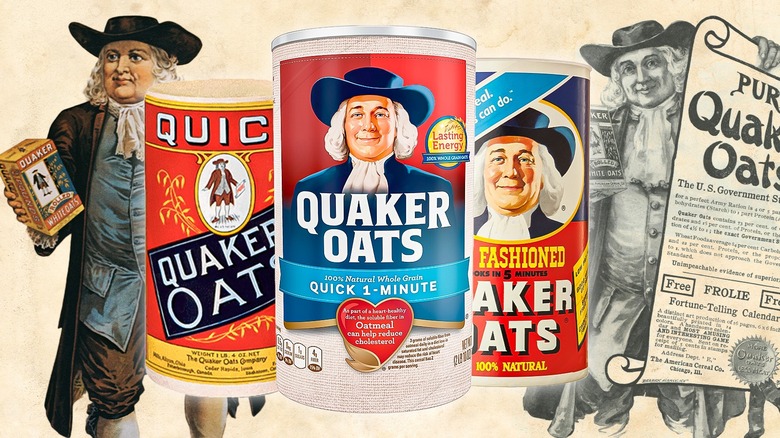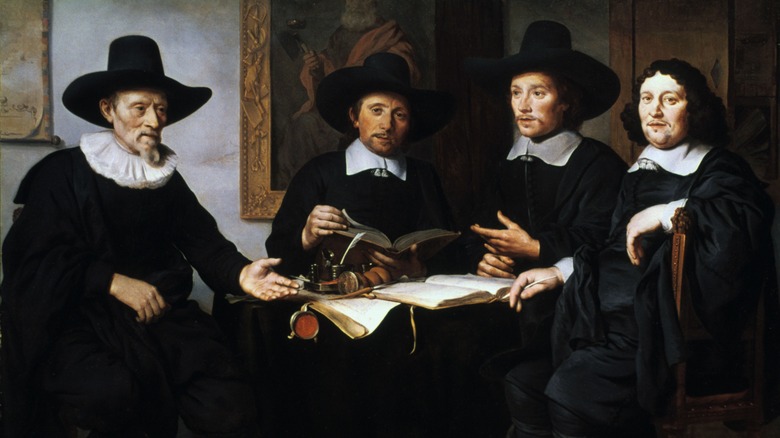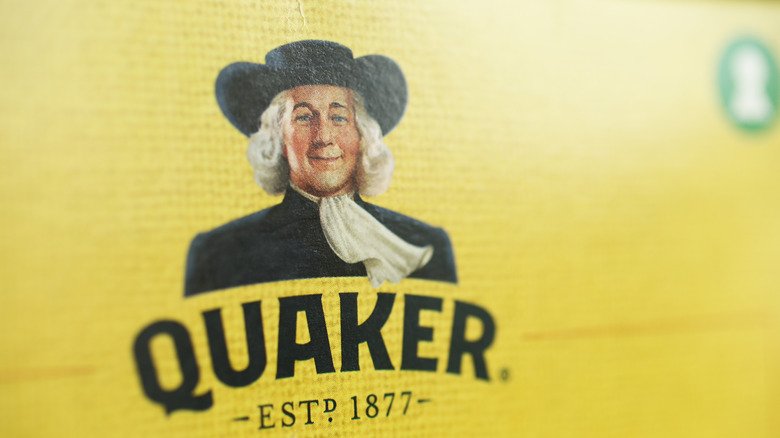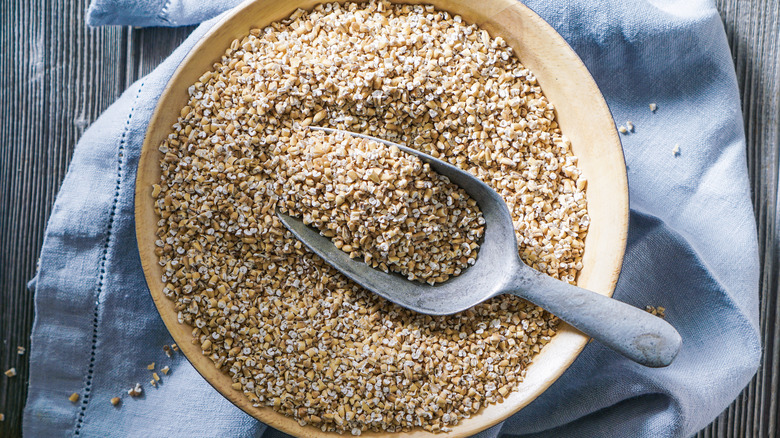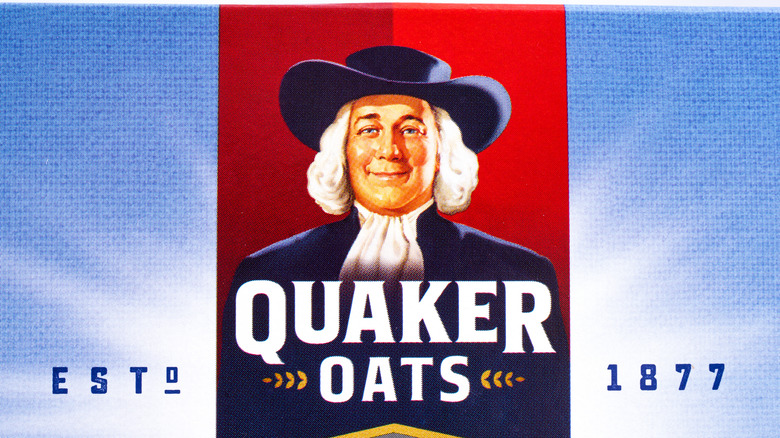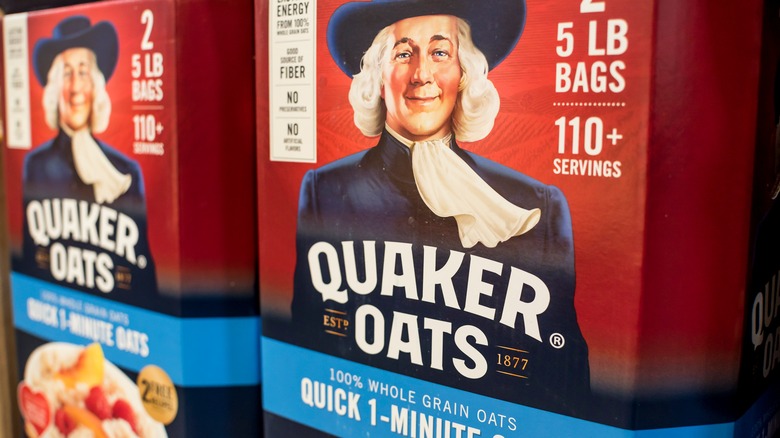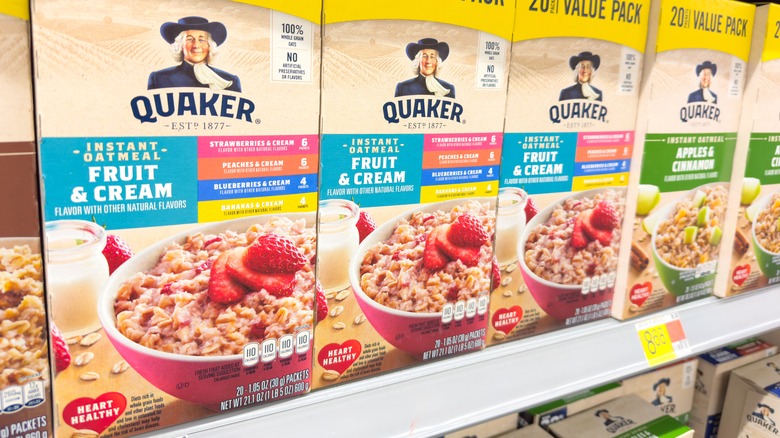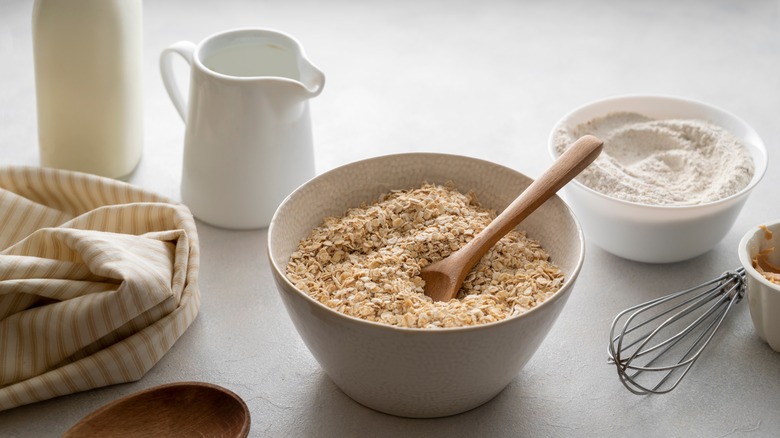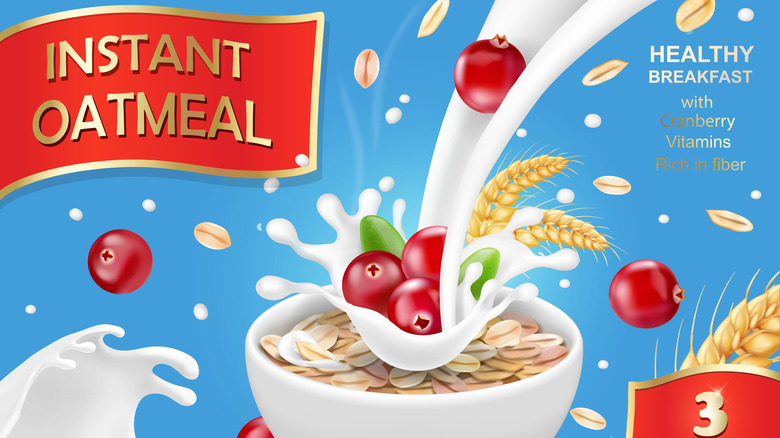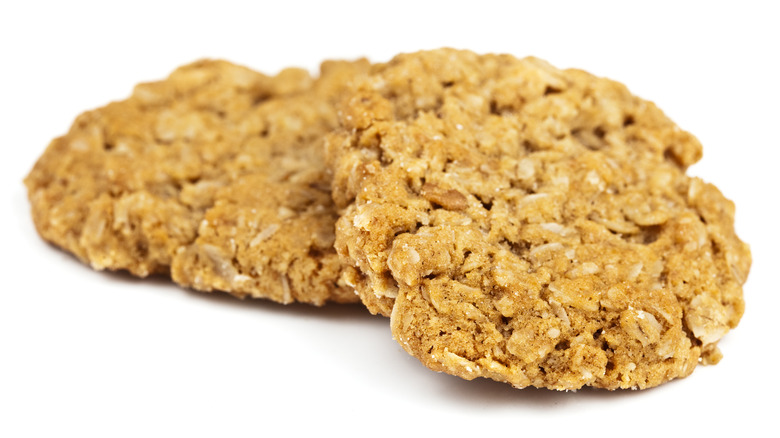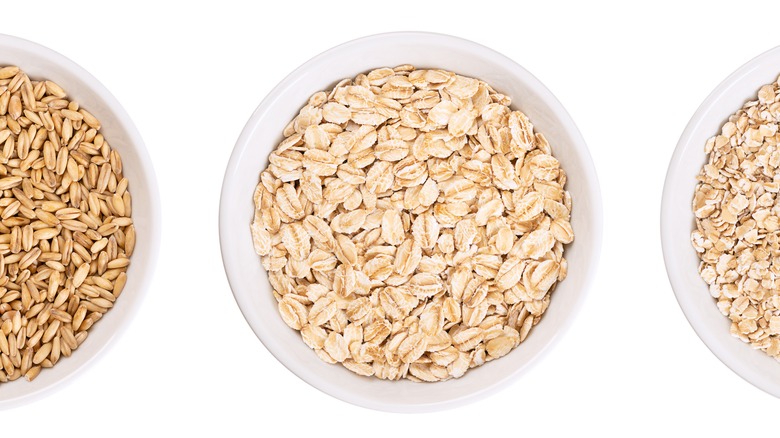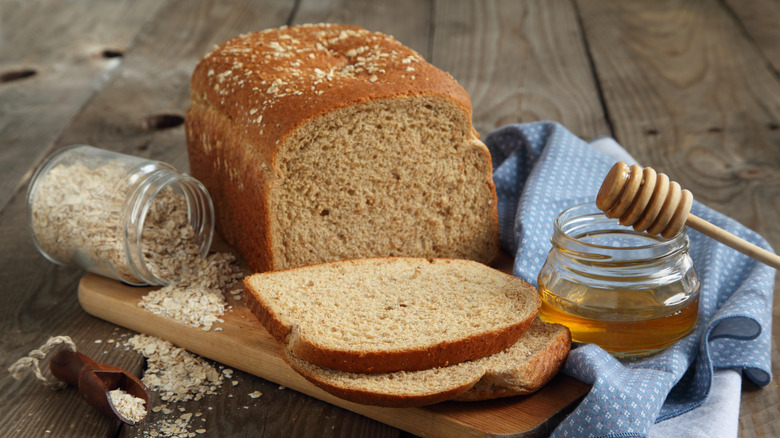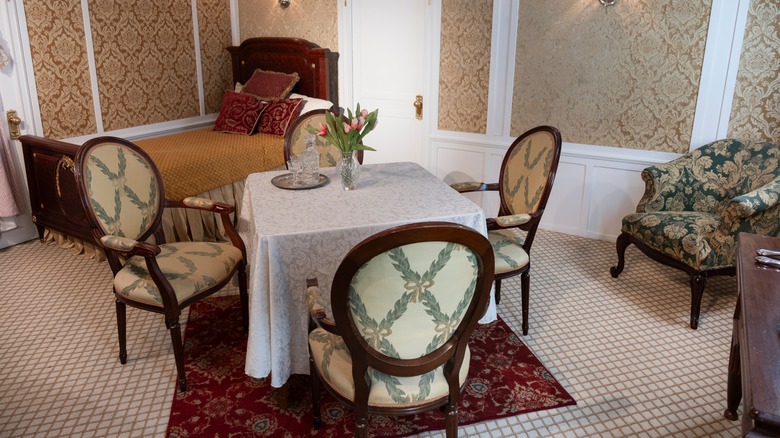13 Facts You Should Know About Quaker Oats
Nothing says breakfast like a piping hot bowl of oatmeal. Whether you're enjoying the traditional rolled oats topped with chopped fruit, overnight steel cut oats, or microwaving a quick bowl of instant oats poured from a paper packet, there's no more recognizable brand of oats than Quaker Oats. They're the gold standard that most of us call to mind when the subject of oatmeal comes up, and for good reason. The company has been instrumental in how we eat breakfast and snacks. They're affordable, easy to prepare, nutritious, and convenient.
The Quaker Oats story began in the 1850 when the German Mills American Cereal Company was created in Akron, Ohio by Ferdinand Schumacher. The company merged with other cereal companies over the years and, in 1901, changed its name to the Quaker Oats Company. Since its inception, the Quaker Oats company has been a hotbed of innovative business, historic firsts, and controversy. These are the surprising facts you should know about Quaker Oats.
The company is not connected to the Quaker religion
The Quaker Oats company has been a trailblazer in the breakfast cereal industry in a number of ways. They have a history of being at the front end of innovative marketing strategies which have helped them cement their place in the hearts of many who consider a bowl of Quaker Oats part of a quintessential American breakfast.
A huge part of their appeal and their marketing prowess is the decision to choose the word Quaker for their company, despite the fact that neither of the owners had any connection to the Quaker religion. So what would inspire the owners to choose this name? Created in the 17th century, the Quaker religion, also known as The Religious Society of Friends, believes in principles like peace, equality, integrity, and simplicity. To many Americans, Quakers are synonymous with purity and goodness. When choosing a name for their company and their cereal, owners Henry Seymour and William Heston were strategic in choosing the work Quaker. To them, it signaled to consumers that their company, like the Quaker people, would be honest and good.
The mascot is known as Larry
Once the German Mills American Cereal Company became Quaker Oats, the owners chose to create a visual representation of the purity and wholesomeness they hoped to project for their brand. Enter the Quaker Oats man. The image of a smiling, white-haired man is likely what comes to mind when the topic of oats comes up.
When Quaker registered their first trademark in 1877, it was described as "a figure of a man in Quaker garb." This first image was a full-body sketch of a man holding a paper that read "pure." Many might be surprised to learn the Quaker man is not a real person. Rumors have persisted for years that the figure was William Penn, the founder of Philadelphia, but the truth is far less exciting. The Wall Street Journal reports that the team at Quaker Oats simply refers to their fictional mascot as Larry.
Larry has gone through numerous glow ups since that first drawing. The first headshot we're all familiar with was created in 1956. Larry went full color in 1957. He went through a brief color-blocking phase in the seventies before his transformation to the man we're used to seeing emblazoned on our oatmeal products.
Quaker's first product was steel cut oats
Quaker Oats is likely most known for its rolled oats and instant oatmeal, but the first cereal product they brought to the market was actually steel cut oats. Steel cut oats are oats that have been minimally processed. Instead of being steamed and flattened like rolled oats, for steel cut oats the oat is chopped into pieces that resemble rice. They have a chewier texture and take longer to cook than rolled oats.
Oats were a popular crop in Europe, but in the United States, steel cut oats were used as animal feed until well into the 19th century. Even today, more than 90% of oats are used to feed animals. This made it hard for Quaker Oats founder Ferdinand Schumacher to sell the public his oats as a meal for humans.
The tide turned when Schumacher began to sell rolled oats instead. Rolled oats were faster to cook and were an instant hit. Rolled oats were even used to feed troops during the Civil War. Schumacher was so successful with oats he earned the nickname the "Oatmeal King."
Quaker filed the first trademark for a breakfast cereal
Ferdinand Schumacher wasn't the only cereal game in town when he began selling his steel cut and rolled oats in America. One of his biggest competitors was Henry Parsons Crowell, who owned the Quaker Oat Mill. In 1877, Crowell registered a trademark for Quaker Oats, which featured the original image of the fictitious character in Quaker clothes. This was the first trademark in history for a breakfast cereal.
Crowell was so successful at this point that Schumacher's business began to suffer. After years of fierce competition, Crowell and Schumacher eventually merged their companies, along with five other cereal producers, to create the American Cereal Company, which was later renamed the Quaker Oats Company.
The trademark was significant not only because it was the first, it also set the tone for other companies to protect their brands and it was a preview of the company's forward thinking in the areas of branding and marketing.
Quaker started the recipe on packaging trend
The oat millers who started the Quaker Oats company have changed more than the way Americans eat breakfast. Those entrepreneurs were skilled at much more than milling and selling oats. Their success was in large part based on the quality of their products and their stellar marketing and branding skills.
This combination is likely one reason why they achieved so much success so quickly. In 1901 when the company traded in the American Cereal Company name to officially become the Quaker Oats Company, it boasted sales of $16 million. That's the equivalent of more than $590 million today.
After registering their trademark, Quaker's next step toward brand domination was a simple but clever one. They began printing recipes on their oats packaging in 1886, making them the first company to do so. The recipe was for oatmeal bread.
It's commonplace today to find product recipes on food packaging, but that wasn't always the case. We can all thank the Quaker Oats company for everything from the Nestle Tollhouse Cookie recipe found on every bag of their semisweet chocolate chips to the Rice Krispie Treats recipe that's printed on every box of the eponymous puffed rice cereal. This trend may not have taken off if not for Quaker's first step.
The first food specific health claim for oatmeal was thanks to Quaker Oats
One stroll through the aisles of your closest grocery store will make it clear that foods labeled as healthy in one capacity or another are extremely popular. Today's markets showcase products labeled gluten-free, dairy-free, low-sodium, heart-healthy, and more. If you're looking for a cure for whatever ails you, chances are there's a food product with a label telling you how it can improve your health.
The Food & Drug Administration (FDA), which regulates the safety of the country's food supply, issues food-specific health claims to inform consumers and help them make smart choices. Since 1990, the FDA has issued 12 health claims. One of those claims was for oatmeal.
As society's interest in healthy living gained popularity, Quaker filed a petition and as a result, the FDA issued a health claim for oatmeal declaring that the fiber in oatmeal, if consumed as part of a diet low in cholesterol, and saturated fat, may lower the risk of heart disease.
Radioactive Quaker Oats were once fed to kids as an experiment
Quaker Oats has built its image as a wholesome, healthy option for breakfast and snacks. Seeing Larry's warm, smiling face on boxes of rolled oats, packets of instant oatmeal, and granola bars is supposed to warm our hearts and remind us of the goodness of Quaker Oats and their wholesome image. Unfortunately, the company hasn't always been as wholesome as they'd like us to believe.
Beginning in 1949, young male students at the Fernald State School, once known as the Massachusetts School for the Feeble-Minded, were coaxed into joining the science club with the promise of receiving free breakfasts and other perks. Little did they know they were actually being used as human guinea pigs for a potentially dangerous scientific experiment. The boys ranged in age from 10 to 17.
Unbeknownst to them, the science club was really a front for an experiment conducted by the Massachusetts Institute of Technology (MIT) with support from the Quaker Oats company. The boys were fed radioactive Quaker Oats in order to help Quaker refute claims that their rival cereal, Cream of Wheat, made it easier for consumers to absorb iron.
Quaker eventually settled a lawsuit regarding these experiments with a $1 million payout. Fortunately, the boys were not injured by the radioactivity that was fed to them.
The Quaker Oats company leaders were marketing masters
The early leaders of the Quaker Oats company were trailblazers when it came to marketing. From selecting a brand image meant to evoke trust and integrity to printing recipes on its product packaging, it made decisions that not only increased sales of its products, but also changed the game for other businesses. This continued in more recent years with recognizing the significance of petitioning the FDA for an oatmeal-specific health claim.
The company has always been at the forefront of marketing, even as far back as 1882 when it ran the first magazine ad for a breakfast cereal. In 1889 when it made breakfast history again by introducing the first trial-size sample box of Quaker Oats. The tiny boxes were delivered by kids on bicycles to every home in Portland, Oregon.
The company also was the first to advertise their product on a train. In 1890, it had the company name painted on all of the cars of what it called the all-Quaker Oats train, which traveled from Cedar Rapids, Iowa to Portland, Oregon.
They have many uses
It's no secret that oats can be put to use in countless ways in the kitchen. You can add them to your muffins for a healthy snack, bake them up in tasty oatmeal snack bars, or make a hearty oatmeal soda bread. You can even grind your oats into oat flour to bake up chewy oatmeal raisin cookies.
Quaker Oats might be the star of our breakfast and snack menus, but they can also be put to use in a number of surprising ways outside of the kitchen, like skincare. The American Academy of Dermatology has declared oats as a powerful tool for calming itchy skin. You can add them to your natural face masks or make a face scrub by mixing oats with water and a little salt.
An uncovered bowl of oats in your refrigerator can eliminate odors, much like baking soda. You can also keep your kids busy with a DIY play dough made with oats.
They're nutritious no matter the variety
Quaker Oats are available in four basic varieties – steel-cut, old fashioned, quick cook, and instant. The key differences between them are related to their shape, texture, and cooking time. All four varieties of oats are equally nourishing.
They're all 100% whole grain, which means they contain all parts of the original grain kernel, the bran, germ, and endosperm. Steel cut oats are coarser in texture and take longer to cook. Old fashioned oats, also known as rolled oats, are cut into flat flakes. They cook in about five minutes. Quick cook oats are slightly smaller than old fashioned and they cook on the stovetop in about a minute. Instant oats are cut finely, almost to a powder. They cook in minutes.
The U.S. Department of Agriculture (USDA) reports that one cup of cooked oatmeal clocks in at 166 calories and four grams of fiber. Oats are also good sources of vitamin B and manganese, which boosts immunity and helps stabilize blood sugar and cholesterol.
They're not just for breakfast
Quaker Oats hold a special place on our breakfast menus but they're also a delicious addition to other recipes that are perfect for enjoying throughout the day and night. When you take into consideration how good oatmeal is for you, why wouldn't you want to eat them for breakfast, lunch and dinner?
Quaker has already taken advantage of America's love for oats by creating a host of products made with them that aren't just for breakfast. Need a portable snack when you're on the go? Grab a granola bar. Even the Quaker oatmeal squares can be added to your favorite trail mix and enjoyed as a snack any time of day.
At home, you can incorporate Quaker Oats into a number of recipes. Oatmeal cookies are a no-brainer, but oats can also add texture and flavor to cowboy cookies, a delicious cookie filled with oats, coconut, pecans, and chocolate chips, and chocolate oatmeal cookies, a no bake oatmeal cookie made with peanut butter and cocoa powder. A delicious oatmeal bread, similar to the one printed on the Quaker Oats containers in the 1800s, is a savory option for your oats.
They have a Titanic connection
Yes, that Titanic! Quaker Oats made their way on board the ill-fated voyage of the Titanic in more ways than one. The oats were featured on the breakfast menu of the first class dining room alongside items like baked apples, fresh herring, and grilled mutton kidneys.
In addition, Walter Douglas, who was a former Quaker Oats president and board member, died in the Titanic tragedy. He boarded the ship with his wife, Mahala, on their way home from a European vacation they'd booked to celebrate his retirement earlier in the year. Douglas is reported to have refused to board a lifeboat until all women and children had been safely removed from the ship. He was spotted lowering the final lifeboat into the ocean.
The bottom of the ocean isn't the only odd place Quaker Oats have traveled. They've gone to outer space as part of astronaut meal packets and to both the North and South Poles with explorers Robert Peary and Richard Byrd respectively. The oats have even climbed Mount Everest, carried by climbers who need a nutrition boost.
The company holds two world records
Quaker Oats' street cred as an industry trendsetter is unmatched. They've revolutionized the way we eat breakfast and led the way in marketing and branding for their entire industry. In addition to all of their advancements and products, the company also currently holds two world records.
One of those records is for a project that is not even related to oats or food in general. In 1982, in an effort to expand the business, the Quaker Oats company created a video game division. US Games released more than a dozen video games for use with the Atari 2600 gaming system. They were the first food company to open a video game division. Unfortunately, none of the video games were a hit, and US Games was closed less than a year after it opened.
Quaker Oats' second world record is due to their Cedar Rapids, Iowa plant. The World Record Academy reports Quaker Oats holds the record for the world's largest cereal plant. It has 13 floors and holds 740 employees.
